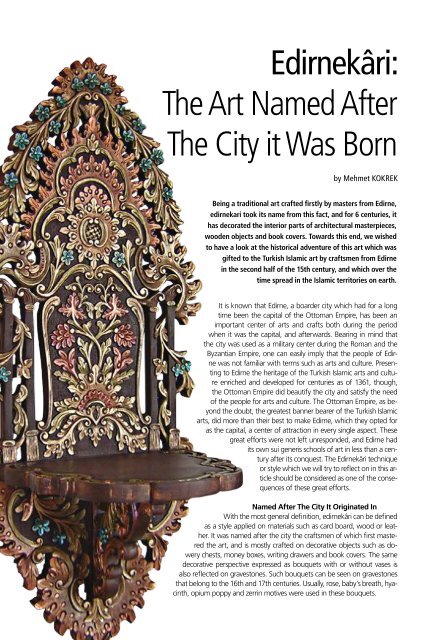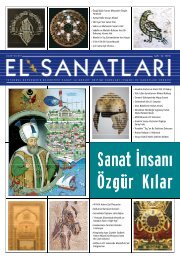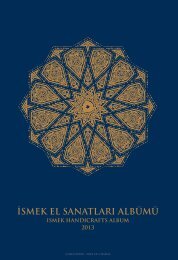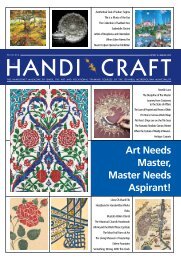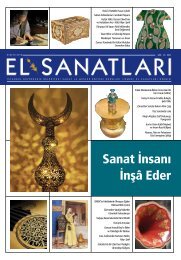Edirnekâri:The Art Named AfterThe City it Was Bornby Mehmet KOKREKBeing a traditional art crafted firstly by masters from Edirne,edirnekari took its name from this fact, and for 6 centuries, ithas decorated the interior parts of architectural masterpieces,wooden objects and book covers. Towards this end, we wishedto have a look at the historical adventure of this art which wasgifted to the Turkish Islamic art by craftsmen from Edirnein the second half of the 15th century, and which over thetime spread in the Islamic territories on earth.It is known that Edirne, a boarder city which had for a longtime been the capital of the Ottoman Empire, has been animportant center of arts and crafts both during the periodwhen it was the capital, and afterwards. Bearing in mind thatthe city was used as a military center during the Roman and theByzantian Empire, one can easily imply that the people of Edirnewas not familiar with terms such as arts and culture. Presentingto Edirne the heritage of the Turkish Islamic arts and cultureenriched and developed for centuries as of 1361, though,the Ottoman Empire did beautify the city and satisfy the needof the people for arts and culture. The Ottoman Empire, as beyondthe doubt, the greatest banner bearer of the Turkish Islamicarts, did more than their best to make Edirne, which they opted foras the capital, a center of attraction in every single aspect. Thesegreat efforts were not left unresponded, and Edirne hadits own sui generis schools of art in less than a centuryafter its conquest. The Edirnekâri techniqueor style which we will try to reflect on in this articleshould be considered as one of the consequencesof these great efforts.Named After The City It Originated InWith the most general definition, edirnekâri can be definedas a style applied on materials such as card board, wood or leather.It was named after the city the craftsmen of which first masteredthe art, and is mostly crafted on decorative objects such as dowerychests, money boxes, writing drawers and book covers. The samedecorative perspective expressed as bouquets with or without vases isalso reflected on gravestones. Such bouquets can be seen on gravestonesthat belong to the 16th and 17th centuries. Usually, rose, baby’s breath, hyacinth,opium poppy and zerrin motives were used in these bouquets.
When applied on wood, Edirnekâri can be handled under3 technical categories: Carved works, inlaid worksand paint decorated works. In addition to this technicaldifferentiation, one can also differentiate the worksof art according to their fields of use under 4 categories:Decorative works, objects for daily use, lecterns andother works of art.Gifted to the Turkish Islamic arts by the craftsmen ofEdirne in the second half of the 15th century, Edirnekâribecame widespread within a large area in the Ottomanterritories. Crafted by masters of various cities such asErzurum, Diyarbakir, Hakkâri, Tirnova, Bursa, Istanbul,Kairo and Akkâ, the art lost its well-known reputationafter the second half of the 20th century. The edirnekariworkshops opened in various cities, mainly in Edirne,Bursa and Istanbul, played the leading role in keepingalive and developing this art which spread within such alarge and distant area.The fact that there is no signature in most of the worksof art which were created in the edirnekâri workshops,though, unfortunately caused many of the craftsmen ofthis art to not be known. The only resources about themasters of edirnekari are signatures found on the worksof art created by masters who worked independently ofworkshops, some written works about edirnekâri, somerecords and archive documents.Has A Wide Range Of ApplicationThe edirnekari style applied on wooden objects in particularhas a wide range of application. Crafted on variousobjects such as cupboards, doors, window frames,lamp stands, ceilings, drawers, trays, watch boxes, Qurancases and writing utensils, another group of objectson which the art is crafted are book covers. It is possibleto see book covers on which the art is crafted, in theTopkapi, Selimiye and Nuru Osmaniye Libraries. Thereare also some unsigned book covers with the decorationof Edirnekari. One of the most beautiful samplesof Edirnekari on book covers is the cover of the albumwhich contains the tughra of Sultan Ahmed the third,in the 3. Ahmed Library in the Topkapi Palace Museum.The work of art which bears the signature Ahmed,
- Page 1:
Art Leads Oneto Eternity!
- Page 4 and 5:
In ThisEdition1506The StringentMast
- Page 6:
Dear Istanbulians,After the industr
- Page 10 and 11:
One Marbler Has Carried This Colorf
- Page 12 and 13:
this art”. Being single those day
- Page 14 and 15:
in flower marbling.” He says, and
- Page 16 and 17:
Cicek Derman: The DoyenneFlower of
- Page 18 and 19:
and does not want her to either stu
- Page 20 and 21:
der the very inside of you.” She
- Page 22 and 23:
ate” at all. The creator is one,
- Page 25 and 26:
Kundekâri:The Time Defying Heritag
- Page 27:
Cracks and incisions which could oc
- Page 30 and 31: land to understand weather he can p
- Page 32 and 33: When Deep WavesWash Ashore!by A. Ul
- Page 34 and 35: 'Bismillah' by Omer Faruk Deretaste
- Page 36 and 37: 'The Asr Surah' by Mustafa Cemil Ef
- Page 38 and 39: Van Gogh,The Genious Painter of Yel
- Page 40 and 41: and anxieties that surrounded him s
- Page 42 and 43: The most prominent features which w
- Page 44 and 45: Starry Night Over the Rhonehe opted
- Page 46 and 47: the left side of his face is a colo
- Page 48 and 49: The Threaded Version of Silver isRe
- Page 50 and 51: out from a narrower hole. Theseoper
- Page 52 and 53: Sumi-e: The Elegance which Comesint
- Page 54 and 55: traditions, perform this art seated
- Page 56 and 57: sumed in half an hour after it is p
- Page 59 and 60: er in ISMEK, after her illumination
- Page 61 and 62: 59Illustration: Hatice Ozturk
- Page 63 and 64: there was a captures chamberlain. 5
- Page 65 and 66: lack sides. As far as I can see del
- Page 67 and 68: One of the founders of the civilisa
- Page 69 and 70: The miniature by Ochiai Yoshiiku da
- Page 71 and 72: Miniatures are in the Irony of West
- Page 73 and 74: pictions of various countries, coul
- Page 75 and 76: A miniature example from the work n
- Page 77 and 78: “Ve mâ rameyte iz rameyte ve lak
- Page 79: usually there is a part consisting
- Page 83 and 84: What is very distinct regardingthe
- Page 85 and 86: The ceiling decorations, corner cab
- Page 87 and 88: There is an epigram for the Artof C
- Page 89 and 90: If the paper had spoken and told wh
- Page 91 and 92: nailing, gluing or compressing of t
- Page 93 and 94: gold. The notebooks with gold leave
- Page 95 and 96: laminary and get the required thick
- Page 97 and 98: Both the insufficience of green fie
- Page 100 and 101: 15 years ago, Mr. Yesilce allocated
- Page 102 and 103: On the Zoomorphic1Originsof the Rum
- Page 104 and 105: Shape-6Shape-13another finding foun
- Page 106 and 107: The Harem in the Topkapi Palace,The
- Page 108 and 109: very much like the school of boys i
- Page 110 and 111: The Blue Doors of TunisiaThe Articl
- Page 112 and 113: Tunisia is the pearl of the Mediter
- Page 114 and 115: Ottoman CultureProducts from Qadi R
- Page 116 and 117: An Overview of Written Sourcesin Ot
- Page 118 and 119: Signature of Abdulhamit II on the c
- Page 120 and 121: Pieces of Wastepapers TurnInto Jewe
- Page 122 and 123: in a short time, we ask him to make
- Page 124 and 125: Symbols of theLife of Thoughtby Pro
- Page 126 and 127: The Gulpayegan Masjid Kufi writing
- Page 128 and 129: which show some of the monumental w
- Page 130 and 131:
An appearance from the interior of
- Page 132 and 133:
The Kufic script at the top is prep
- Page 134 and 135:
in yerinize grafologla konusuverir.
- Page 136 and 137:
considered as a hard science rather
- Page 138 and 139:
Zeynep Bornovali states that differ
- Page 140 and 141:
The Dance of the Needle with Cerami
- Page 142 and 143:
was not the case, however, for the
- Page 144 and 145:
an area determined on the material
- Page 146 and 147:
Dilek Hanif: A Fashion DesignerWho
- Page 148 and 149:
others prefer to have a single and
- Page 150 and 151:
Princess Nazli:The Patron of Arts a
- Page 152 and 153:
which was also known as “Villa He
- Page 154 and 155:
A Bouquet From the Hidden Paradiseb
- Page 156 and 157:
Canfeza (Heart touching) A fully st
- Page 158 and 159:
“Someone whom I hadn’t met befo
- Page 160 and 161:
The Storm of ISMEK Blowingin the In
- Page 162:
Menaf Nam's work which was awarded


